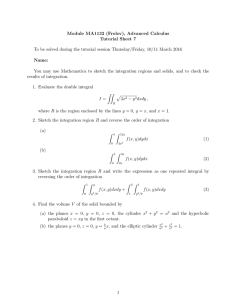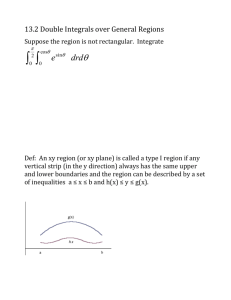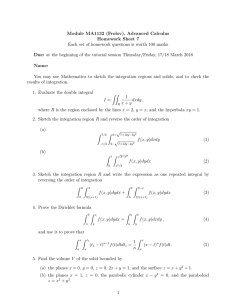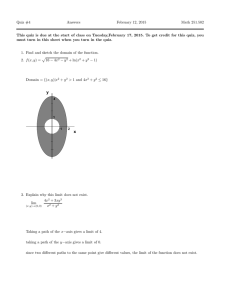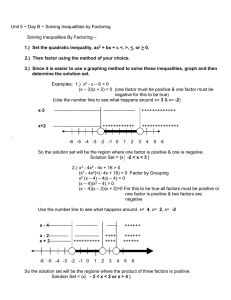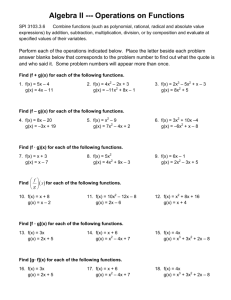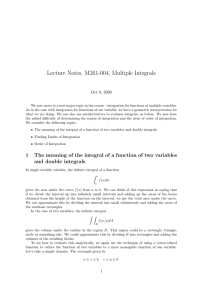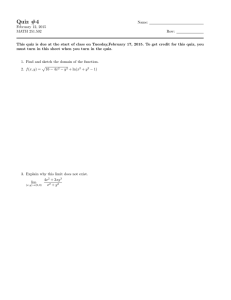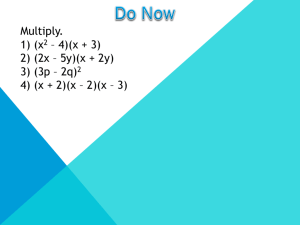Module MA1132 (Frolov), Advanced Calculus Tutorial Sheet 7
advertisement
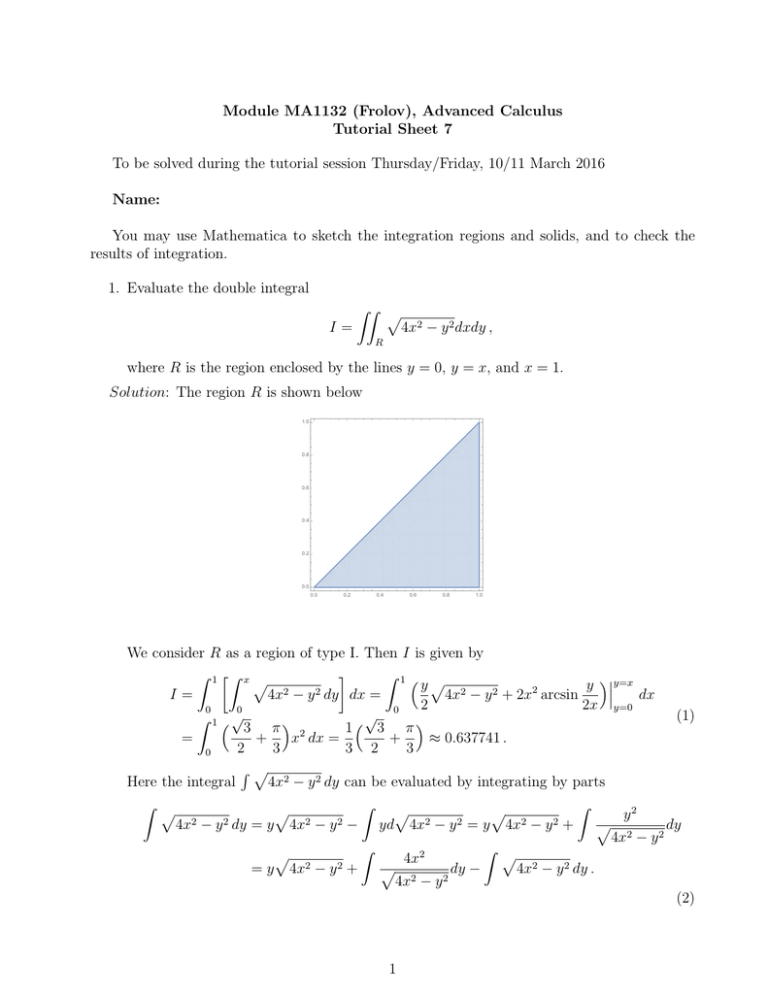
Module MA1132 (Frolov), Advanced Calculus Tutorial Sheet 7 To be solved during the tutorial session Thursday/Friday, 10/11 March 2016 Name: You may use Mathematica to sketch the integration regions and solids, and to check the results of integration. 1. Evaluate the double integral ZZ p 4x2 − y 2 dxdy , I= R where R is the region enclosed by the lines y = 0, y = x, and x = 1. Solution: The region R is shown below 1.0 0.8 0.6 0.4 0.2 0.0 0.0 0.2 0.4 0.6 0.8 1.0 We consider R as a region of type I. Then I is given by Z 1 Z x p Z 1 p y y y=x 2 2 dx I= 4x − y dy dx = 4x2 − y 2 + 2x2 arcsin 2 2x y=0 0 0 0 √ (1) Z 1 √ 3 π 2 1 3 π = + x dx = + ≈ 0.637741 . 2 3 3 2 3 0 Rp Here the integral 4x2 − y 2 dy can be evaluated by integrating by parts Z p Z Z p p p y2 2 2 2 2 2 2 2 2 4x − y dy = y 4x − y − yd 4x − y = y 4x − y + p dy 4x2 − y 2 Z Z p p 4x2 2 2 p = y 4x − y + dy − 4x2 − y 2 dy . 4x2 − y 2 (2) 1 Comparing the l.h.s with the r.h.s, one finds Z Z p yp 4x2 1 p 2 y 2 2 2 4x − y dy = y 4x − y + p 4x2 − y 2 + 2x2 arcsin . dy = 2 2 2x 4x2 − y 2 (3) One can add any function of x to this expression which does not change the definite integral. 2. Sketch the integration region R and reverse the order of integration (a) 4 Z 12x Z f (x, y)dydx (4) 3x2 0 Solution: The region R is shown below 40 30 20 10 0 0 1 2 3 Reversing the order of integration one gets Z Z 4 Z 12x f (x, y)dydx = 0 3x2 4 48 Z √y/3 f (x, y)dxdy . 0 (5) y/12 (b) 1 Z Z 3x f (x, y)dydx 0 2x Solution: The region R is shown below 3.0 2.5 2.0 1.5 1.0 0.5 0.0 0.0 0.2 0.4 0.6 2 0.8 1.0 (6) Reversing the order of integration one gets the sum of two repeated integrals 1 Z Z 3x 2 Z y/2 Z f (x, y)dydx = 0 3 Z Z 1 f (x, y)dxdy + 2x 0 y/3 f (x, y)dxdy . 2 (7) y/3 3. Sketch the integration region R and write the expression as one repeated integral by reversing the order of integration Z 3Z 1 Z 1Z y f (x, y)dxdy (8) f (x, y)dxdy + 0 y 2 /9 1 y 2 /9 Solution: The region R is shown below 3.0 2.5 2.0 1.5 1.0 0.5 0.0 0.0 0.2 0.4 0.6 0.8 1.0 Reversing the order of integration one gets Z 1 Z y Z 3 Z 1 Z f (x, y)dxdy + 0 y 2 /9 1 Z f (x, y)dxdy = 1 y 2 /9 √ 3 x f (x, y)dydx . 0 (9) x 4. Find the volume V of the solid bounded by (a) the planes x = 0, y = 0, z = 0, the cylinder x2 + y 2 = a2 and the hyperbolic paraboloid z = xy in the first octant. Solution: The solid, and its projection R onto the xy-plane are shown below (a = 2) 3 2.0 1.5 1.0 0.5 0.0 0.0 0.5 1.0 1.5 2.0 Thus, the volume is ZZ Z V = a √ Z xydxdy = R 0 0 a2 −x2 1 xydydx = 2 Z a 0 1 1 1 x(a2 − x2 )dx = a4 − a4 = a4 . 4 8 8 (10) 2 2 (b) the planes y = 0, z = 0, y = ab x, and the elliptic cylinder xa2 + zc2 = 1. Solution: The solid, and its projection R onto the xy-plane are shown below (a = 1, b = 2, c = 3) 2.0 1.5 1.0 0.5 0.0 0.0 0.2 0.4 0.6 0.8 1.0 Thus, the volume is r ZZ r Z a Z bx/a r Z x2 x2 bc a x2 V = c 1 − 2 dxdy = c 1 − 2 dydx = x 1 − 2 dx a a a 0 a R 0 0 (11) Z 1 √ 1 abc = abc x 1 − x2 dx = −abc (1 − x2 )3/2 |10 = . 3 3 0 4
